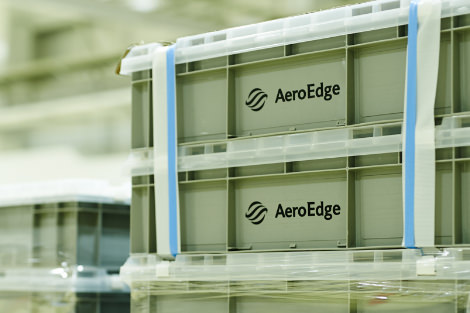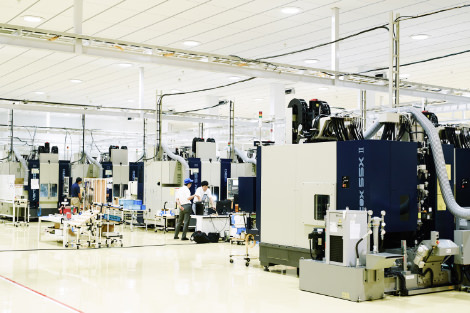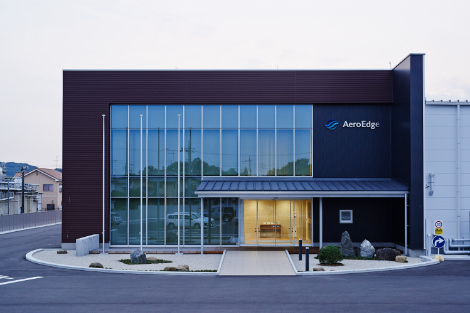We have selected and signed contract directly with a global aircraft engine OEM, the first acheivement as a mid-size company in Japan.
Our company started business January 1, 2016, and begined producing titanium aluminum turbine blades for a next generation jet engine (called “LEAP”) based on a direct contract with SAFRAN AIRCRAFT ENGINES (formerly SNECMA) in France.
Mass-production began in August 2016, a few months after the head factory was completly built in Ashikaga, Tochigi Prefecture. It has only been a short period since AeroEdge began as a full-scale manufacturing company. We think our newness is an advantage, one that highlights creativity to form the most important action guidelines; this develops meaningful work in the global aerospace industry, which refreshes the way Japan’s small and medium manufacturing industry exists.
Prior to our founding, we accumulated technical strength and built a bridgehead in the global market.
In fact, we sought to enter the global aviation manufacturing business long before 2016. Given the uncertainties associated with the supply-chain restructuring of the automobile and construction machinery manufacturers that were the main customers during that time, and combined with the uncertainties of the global economic outlook beginning in 2000, we looked for the area in which we could take advantage of the technological capabilities. After comprehensive consideration, we concluded that the global aviation manufacturing business was the most suitable industry to enter due to the industrial scale, the growth potential, the high added value and the existence of a high hurdle worth the challenge to overcome.
The first step was trading with the major Japanese aerospace industries. By the time business occurred in the mid-2000s, we overcame many challenges to better answer customer demands. Through these activities, we learned a lot, including acquiring technical certifications and how to progress the business with global aviation OEMs.
In this sense, our present situation strongly owes our predecessors who have supported the Japanese aerospace industry so far and have established trust and certain techniques. We would like to become one of the leading Japanese aviation companies in the near future.
We received overwhelming development capabilities and responsiveness.
Our experience developing prototypes for difficult-to-cut materials (including titanium and nickel, titanium aluminum, CMC and other heat-resistant, advanced materials) from 2000 onward has greatly contributed to this direct contract with OEM. As a result of accumulating titanium–aluminum processing experience in dealings with major Japanese aviation industries, we received a very high evaluation for our technical ability to find optimum processing conditions with our developed tool in mass production, along with our selection of the LEAP engine.
As our capability to answer the demands of customers has grown, we have also been highly evaluated: we were the only company that delivered the required prototype quickly. By proceeding quickly, we have deepened trust in our relationship with customers. For example, for both 2D drawings and 3D models, both the original tool and the CAM / CAM program coding were developed quickly. Moreover, the quality assurance method of the products was established in parallel.
In terms of our equipment selection, our domestic and overseas advanced facilities were considered. The negotiation was carried out during the early stages of the investigation, and we have introduced only what is optimal. For instance, in the field of cutting processing, which is our main process, we have maintained the high rigidity of the machines as a result of research and development with Mitsui Seiki Co., Ltd. for several years. The French water jet machine, Aquarese, makes it possible to process complicated shapes using multiple indirect robots in other processing steps. Germany’s digital X-ray machine, Yxlon, specializes in automatic shooting of turbine blades in the field of inspection. We have introduced a non-contact 3D measuring instrument by Wenzel.

MU56TB (YXLON), the first digital x-ray system introduced in Japan
We are equipped with a global perspective supply chain from materials to finished goods.
It is not possible to survive with a single process such as “processing only.” What the global OEM requires of suppliers is not only a single process but also the ability to process materials from procurement to finished products in one stage. In recent years, this tendency has been increasing more and more. Our company was also asked to transform from a simple processing shop into a business entity that could be consistently entrusted with special processes such as nondestructive inspection.
To launch a nondestructive inspection process, there must be at least one certified “Level 3” inspector, according to international standards. We faced serious difficulty: few domestic engineers are at level 3, and furthermore, domestic training resources were very poor. Owing to our customers’ support and relationships overseas, we have built up our own nondestructive inspection team by dispatching our products to France and by receiving training and attending lectures overseas in France and Belgium. For small to medium enterprises that aim to enter the global aviation industry in the future, we contribute to the establishing of autonomous nondestructive inspection certification systems and inspectors’ training systems in Japanese.
We have flexibly responded to the frequently changing production demands by utilizing not only domestic but also overseas suppliers in the early development phase, and we have therefore been highly impacted by the material development section. As of 2017, we have come across a global supply chain that incorporates US suppliers into the mass production supply chain, taking into consideration material recycling.

We are deeply aware of the difference between development and mass production.
The tools required for development and mass production are totally different. As mentioned above, we have won the trust of customers in the development phase, in which we can make only one lot per month. However, the mass production of 5 lots, 10 lots or 20 lots per month is significantly different, so we have to change our mindset in every way.
For the development prototype, it was possible to build highly accurate products that were close to the nominal size of demand by quick generation of the CAM program, machining simulation, and in-house manufacturing of jigs and tools. Nevertheless, since even the same types of jigs, tools, and facilities have certain variations in the mass production, it is necessary to consider robustness. As a matter of course, the initial production system has caused a lot of trouble in the rapid ramp-up.
Regarding the organizational structure, we have also been required to consider, propose and implement our own in order to introduce the sophisticated production plans and approaches to acquire product certification, for which Japanese heavy industry companies were originally responsible.
Since the full-fledged operation in January 2016, we have continuously improved our formations from being zero-based to being a true partner in dealing with global OEMs. We continue to adopt IoT, Big Data Analysis, and AI actively, with the aim of realizing “AeroEdge’s unique smart factory,” and we will continue to be strongly competitive in the market.

Set up our “capability” for entering the global market in 2016.
As of June 2017, our mass production of the turbine blade is finally on track. In addition, we think our experience has prepared us for the minimum “capability” to enter the global market. First, we built a system to create one contract to cover development, mass production and quality assurance. The ability to do everything from supply chain management to quality assurance is always required by customers and is a necessary condition for conducting direct dealings with global OEMs. We have, for instance, established the foundation of an autonomous in-house training system of inspectors who are internationally certified in quality assurance.
The second “capability” is understanding the processing know-how of hard-to-manufacturing materials, such as titanium-aluminum and other composite materials. New materials widely used in the aviation field are difficult to manufacture. We have accumulated the knowledge to respond reliably to customers’ production requirements from a mid- to long-term perspective. This includes the establishment of the methods needed to process these difficult-to-cut materials and the resulting learning curve related to the perspective of mass production through the management of our main business.
The third “capability” is understanding the global aviation industry network. Since AeroEdge was founded, we have been hurriedly building relationships that enable us to have direct conversations with aerospace OEM companies located in many Western countries. We have done this by presenting topics, almost monthly, at overseas exhibitions and establishing direct opportunities to talk business.
We will continue to create something from nothing on a global basis.
Of course, it cannot be said that what we have built during the past year is enough. However, in the future, in an age in which the environment surrounding the aerospace and defense industry—and eventually the manufacturing industry—is about to change drastically, we will use the assets we have built and continue to develop to implement globally meaningful work. To set the company’s direction, we will focus on four main policies.
First, we are searching for a new way to manufacture products in the aeronautical industry. Our current main business focuses on the aviation industry, and in this industry, we will establish the next business venture by following the LEAP business model. Going forward, we aim to acquire business that secures added value in the mid and long term by seeking a strategic position in the global market. The second policy is the promotion of agile, bold, global market-penetrating activities. To understand the potential demand of the market and the timely response to the customers’ requests, I would like to take the basic stance of traveling anywhere in the world without hesitation.

The third policy is innovative business development through broad and flexible inter-company collaboration. We want to build a collaborative relationship from the perspective of creating a business with flexibly diverse enterprises, starting with the development of new businesses.
Finally, the fourth policy is the diversity of business development based on acquired know-how and networks. One future project we plan to pursue will take us beyond the manufacturing industry. We seek to diversify businesses that can demonstrate leverage without compromising the know-how and networks we have cultivated in the manufacturing industry.